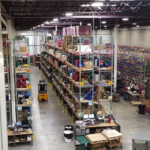Written by Caia Baker VP of Procurement
Fasteners Direct

Inventory management is a critical link in any supply chain. Ensure you continually track what products you have in stock, what’s typically required (and when), the costs, and delivery times to ensure you’re optimizing your revenue and supply-chain relationships.
Whether it’s a buyer of copious quantities of fasteners for ongoing projects or a one-time consumer assembling a work-from-home desk, it’s important to recognize the value of a buyer and supplier interaction within the supply chain.
Treating this exchange as a relationship — and a potential long-term partnership — rather than a transaction is one key to long-term success for both parties.
The global pandemic likely emphasized the significance of the supply-chain partners for many in the fastener industry. Frantic purchases, frequented stockouts, shipping delays, and skeletal workforces highlighted how prepared (or ill-prepared) many companies were to handle the sudden changes and restrictions.
However, it has been said that challenges bring opportunities. If 2020 offered nothing else, it forced companies to re-evaluate their systems for doing business to identify faults and ensure resilience. For many, perseverance was the only option, which meant generating and adopting new ways of conducting business.
This required flexibility and modifications, such as investments in a more secure online presence and remote accessibility for customers and employees. For example, collaborative platforms, such as Microsoft Teams, Dropbox, or Smartsheet, let users transmit data in real-time with the ability to connect, do business, and track orders, etc., digitally. For essential-service manufacturers and suppliers, it also meant re-distributing the workforce for a period of time to meet distancing regulations in an effort to continue meeting customer demands.
The changes and challenges over the last couple of years also likely strengthened many supplier-buyer relationships. It quickly became evident which companies could meet the challenges and remained dependable.
Despite the disruptions from the pandemic, however, there are some things that never change when it comes to good business relationships. Whether you’re a manufacturer, supplier, or buyer in the industry, here are some tips to ensure a good relationship with your customers.
It starts with communication. A wise person once said, “communication is key.” Within the supply chain, communication is imperative. This is no time for modesty or timidity. Be clear about what you want and truthful about you can offer or budget for.

Post-pandemic wholesalers are maintaining stock in efforts to prevent any unforeseen delays. This warehouse has stocked its most frequented items to ensure no stockouts.
Moreover, prioritize those stakeholder relationships and regularly keep in contact. If you’re a manufacturer or supplier, keep customers appraised of your products and offerings. Offer options and good service. Beyond mass emails or e-newsletters, it’s worth personally reaching out to customers to maintain a good bond.
If you’re a buyer, form a good relationship with your suppliers, so they understand your needs and can then best meet them.
Knowledge is power. There are so many options in the fastener industry. Consumers may be unaware of their choices when it comes to new or full product line capabilities. Suggesting options or providing professional installation tips offers quality incentives.
A specialized customer service team that can share insightful product and assembly knowledge is highly attractive. Material test reports and certificates of compliance are also wise additions to provide consumers with product sourcing knowledge.
Expect competition. The emergence of Amazon Prime has added a new level of competition for certain manufacturers and suppliers. Often suppliers will offer unique components or smaller quantities on third-party sites, such as Amazon.
With e-commerce also becoming more popular, especially since the pandemic, it’s worth surveying the online presence of potential vendor(s) as the heavy hitters will take advantage of several platforms. A stronger online presence might also be something that could serve your company. Know your customers — and your potential new customers.

Identifying supplier relationships that align with your business goals can lead to increased efficiencies and reduce the costs associated with establishing new partnerships.
Exceed expectations. There are basic factors that consumers require from suppliers. And ironically, it’s not simply better pricing, even though this is typically one component. When suppliers met or exceed consumers’ expectations, it’s considered a win-win for all parties involved.
If expectations are unmet, this typically means the stage has not been properly set and better communication — or listening skills— is required. A good rule-of-thumb: under-promise and over-deliver.
Stick to a code. In the fastener industry, standards are critically important to ensure safe assemblies. A code of ethics should also be followed in supply-chain relationships. Trust goes a long way in securing good partnerships. Be honest, keep your word, and be kind.
One best practice is to seek a non-compete supplier. A non-compete agreement provides the assurance that vendors will not sell to or provide a service to the client’s direct competitors or disclose trusted insight or private information.
As a buyer, don’t be shy about a manufacturer or supplier’s values and standards. Ensure what you’re paying for also offers peace of mind, security, and confidence.
Go with the flow. The supply chain is continuously evolving. If nothing else, you can expect challenges and changes over time, which are an important part of development.
Remember, it’s always possible to grow and there are several strategies to improve the bottom line. Don’t be shy when it comes to advancing business practices, trying new digital platforms, or reaching out to new customers.






Tell Us What You Think!